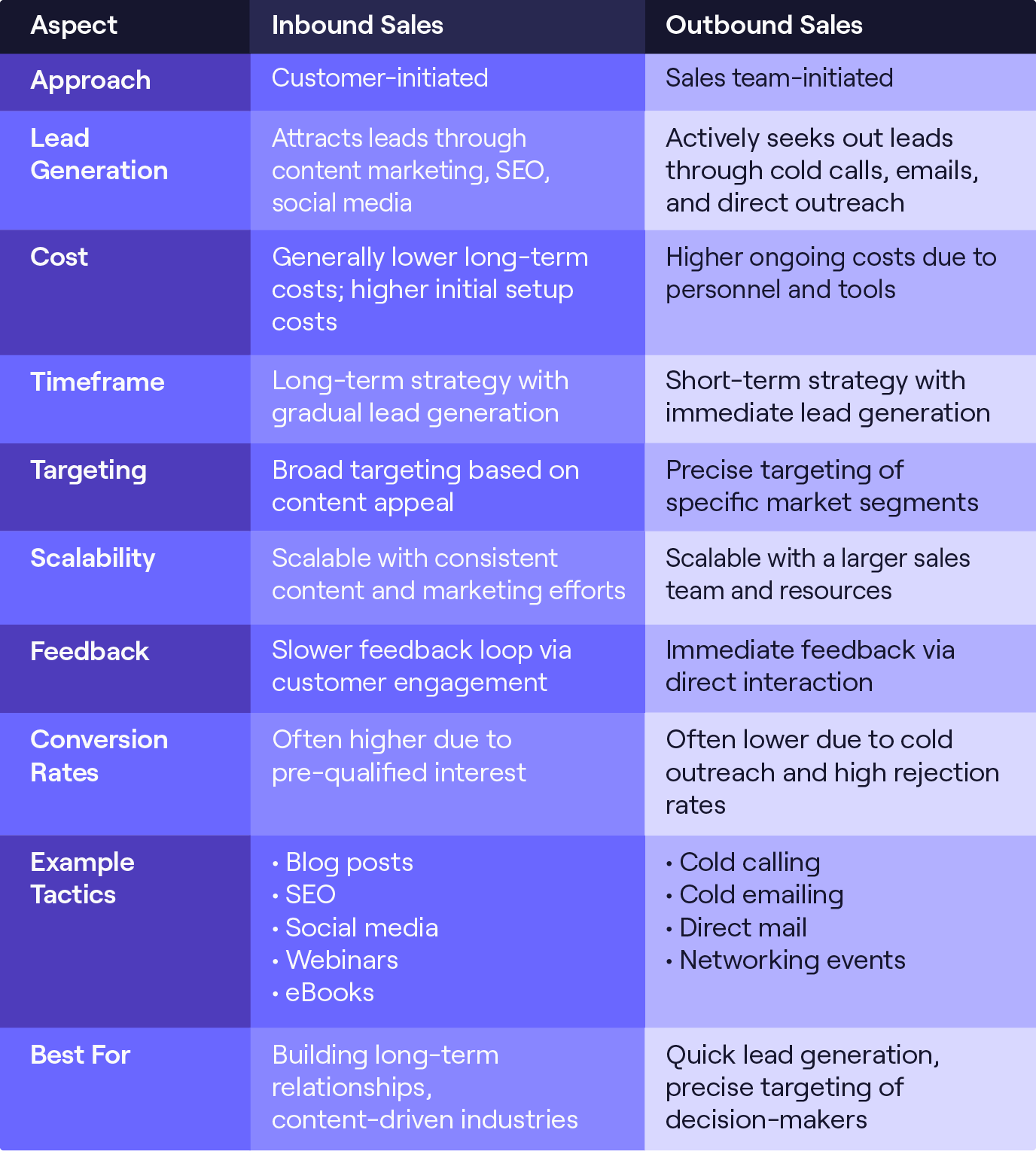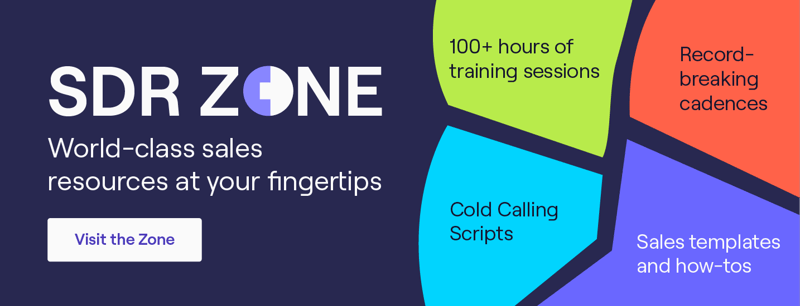What is Outbound Sales? Strategies and Tips for Reps
Outbound sales is a proactive approach to selling where sales representatives initiate contact with potential customers rather than waiting for them to inquire about products or services.
Sales professionals use techniques such as cold calling, emails, or networking to engage and convert cold prospects into paying customers. An outbound sales rep’s goal is to generate leads and close deals.
Browse Cognism’s knowledge hub to discover everything you need to know about the outbound process!
Scroll 👇 or use the menu to navigate around.
What's on this page
What is the outbound sales job description?
Outbound sales can be described as traditional sales. It’s where a sales development rep (or SDR) initiates engagement with a prospect and pitches them a product or service.
Outbound is the most direct way of contacting potential buyers and pitching your product. It’s the best choice for businesses that want to generate some quick wins and turn prospects into customers.
It’s particularly important for growing SaaS sales teams. If you’re a growth-stage SaaS company, then chances are, most people won’t have heard of your brand. Getting an outbound sales strategy up and running is your quickest route to generating new revenue.
Which is better, inbound or outbound sales?
No time to read?
Check out this video explaining outbound vs inbound sales strategies 👇
So, what exactly is inbound sales and how is it different from outbound?
As the name suggests, it’s a lead generation strategy where potential leads come to you. And if they stay engaged with your content, they’ll convert into customers.
Inbound is typically a strategy spearheaded by the marketing team. They create and publish marketing campaigns and online content designed to attract and delight prospective buyers.
The most popular inbound techniques are content marketing, SEO, and social media marketing.
For a full comparison of the outbound vs the inbound approach, see the infographic below 👇

As to which is better - it largely depends on factors such as the type of your business, industry, target market, business goals etc.
Here at Cognism, we’re advocates for the hybrid model. Our marketing team generates and nurtures inbound leads, while our outbound sales team qualifies and converts prospective customers.
Many businesses, ourselves included, find that a combination of inbound and outbound strategies works best!
What are the benefits of outbound?
Outbound selling offers several benefits, particularly for businesses looking to generate qualified leads, target specific markets, and get regular customer feedback.
Here are the key advantages:
1. It’s fast
- Quick results: Inbound sales takes time to build momentum. Outbound sales, on the other hand, can produce immediate leads and sales.
- Control over lead quality: Sales teams can target prospects who match ideal customer profiles, potentially leading to high-quality leads.
2. It’s precise
- Market segmentation: Outbound sales allows businesses to precisely target specific industries, company sizes, or even decision-makers within companies.
- Personalised outreach: Sales reps can tailor their messaging and approach based on each prospect’s needs and pain points.
3. It gives you immediate feedback
- Real-time insights: Direct interaction with B2B buyers provides immediate feedback on their needs, objections, and overall interest. This allows the outbound sales rep to quickly adjust their strategy.
- Market intelligence: Meaningful conversations with prospects can reveal valuable information about market trends, competitor activities, and customer preferences.
4. It’s scalable
- Expandable efforts: Outbound sales efforts can be scaled up quickly by hiring more business development reps and expanding outreach campaigns.
- Replicable processes: Successful outbound sales processes can be documented and replicated, making it easier to train new sales staff and maintain consistency.
5. It improves sales skills
- Skill development: Through repeated interactions with potential customers, outbound sales reps can enhance their skills and approach.
- Experience handling objections: Outbound sales agents become adept at handling objections and overcoming resistance. These are valuable skills in any business context!
6. It compliments inbound sales
- Integrated approach: Outbound sales can complement inbound strategies by reaching out to leads who may not have engaged with inbound content. This integrated approach ensures no potential leads are missed.
- Reactivating dormant leads: Outbound sales can be used to re-engage dormant or inactive leads who may have shown interest in the past but did not convert.
7. It’s efficient
- Focused efforts: Outbound sales focuses efforts on high-value warm leads, ensuring that sales resources are spent on the most promising prospects.
- Predictable pipeline: By maintaining consistent outbound activities, businesses can create a more predictable and manageable sales pipeline.
8. It helps to build relationships
- Personal connections: Direct outreach builds business relationships with prospects, which is instrumental in building trust and closing deals.
- Custom solutions: Reps can offer tailored solutions during their sales conversations, helping them to meet customer needs.
What is the outbound sales process?
Here are the key components and steps involved in outbound selling:
1. Prospecting
It begins with identifying potential leads that fit your buyer personas. Outbound sales agents do this by researching industries, companies, and individuals.
Tools that can help in the prospecting phase include contact databases, social networks, industry publications and CRM systems.
Did you know that Cognism is an excellent prospecting tool? You can use our platform to find the right companies and decision-makers, ALMOST instantly!
See below for a quick product demo 👇
2. Lead generation
In this stage of the process, you must compile a list of leads based on your prospecting research.
It’s a good idea to define criteria for qualifying leads beforehand. They must align with your target market and have the potential to convert.
Check out Cognism’s guide to lead scoring for more info.
3. Initial contact
In this phase, outbound sales agents initiate contact with their leads. They do so via phone calls (cold calling), emails (cold emailing), social media messages, or direct mail.
Personalisation is a big factor in sales calls and emails. You must tailor your outreach message to address your prospect’s needs, pain points, and interests.
4. Lead qualification
Arguably the most important step in any outbound sales campaign. It’s where you must assess your lead’s interest and potential fit with your product.
To successfully evaluate leads, use qualification frameworks like BANT (Budget, Authority, Need, Timing) or CHAMP (Challenges, Authority, Money, Prioritisation).
5. Sales pitch
Once you’ve qualified your leads, it’s time to present them with a compelling sales pitch!
The best pitches and demos highlight a product’s benefits/value and clearly illustrate how it can solve the prospect’s problems.
6. Handling objections
Ignoring all types of sales objections will get you nowhere! Instead, you must actively listen to the prospect’s concerns.
The best way to address objections is to be clear, concise, and persuasive. Be sympathetic in alleviating concerns and proactive in providing solutions.
7. Closing the sale
Negotiate terms, pricing, and conditions with the prospect to reach a mutually beneficial agreement.
When you’ve secured a commitment from the prospect, work with your legal team to draw up a contract.
8. Follow-up
Ensure a smooth transition from sales to customer onboarding, providing any necessary support and resources.
Maintain good customer relationships by addressing any issues as they arise. Always keep the customer in mind!
9. Nurturing and upselling
Continue to build and strengthen your customer relationships.
They may need additional help or features; if you spot opportunities to upsell or cross-sell, don’t be shy in coming forward.
10. Data analysis and optimisation
In the final phase of the outbound sales approach, you must monitor your performance using CRM systems and analytics tools.
Collect feedback from your customers to identify areas for improvement.
What are examples of outbound sales?
Here are the most popular outbound sales techniques:
1. Cold calling
- Description: Sales representatives call prospective customers who haven’t previously expressed interest in a product or service.
- Example: A software company’s sales team calls companies in the tech industry, introducing their new project management tool.
Looking for more cold calling and outbound sales tactics? Swing on by to Cognism’s SDR Zone - it’s the number one place for reps to enhance their skills. Click 👇 to access!
2. Cold emails
- Description: Sending unsolicited emails to outbound leads, pitching a product or service.
- Example: A marketing agency sends personalised email sequences to e-commerce store owners, highlighting their expertise in boosting online sales.
3. Direct mail
- Description: Sending physical mail, such as brochures, postcards, or catalogues to potential customers.
- Example: A B2B sales firm sends personalised letters to thought leaders, inviting them to their live event.
4. Social selling
- Description: Reaching out to potential customers through social media platforms like LinkedIn, Twitter, or Instagram.
- Example: A B2B technology company uses LinkedIn to connect with IT managers, sending direct messages about their cybersecurity solutions.
5. Networking events
- Description: Attending industry conferences, trade shows, or expos to meet potential clients face-to-face.
- Example: A financial advisor attends a local business expo to meet small business owners and discuss their financial planning services.
6. Webinars and seminars
- Description: Hosting informational sessions to attract and engage potential customers.
- Example: A B2B marketing firm hosts a webinar on the latest SEO trends and follows up with attendees to discuss their specific needs.
7. Door-to-door sales
- Description: Visiting potential customers in person at their homes or businesses.
- Example: A solar energy company sends sales representatives to neighbourhoods with high electricity rates, discussing the benefits of solar panels.
8. Referral programs
- Description: Encouraging existing customers to refer new clients by offering incentives.
- Example: A logistics company offers discounts to their current clients when they refer a new client who signs up.
9. Partnerships and alliances
- Description: Forming strategic partnerships with other businesses to gain access to their customer base.
- Example: A sales software company partners with a hardware manufacturer to bundle their products and sell to the manufacturer’s existing customers.
10. Sales blitz
- Description: A coordinated effort where a sales team focuses on a specific geographic area or market segment for a short period.
- Example: An insurance company organises a week-long sales blitz where all agents focus on contacting small businesses in a particular city.
11. Account-based marketing (ABM)
- Description: A targeted approach where sales and marketing teams collaborate to create personalised campaigns for individual, high-value accounts.
- Example: A cloud services provider develops tailored account-based marketing materials and sales pitches for the 10 largest enterprises in the healthcare industry.
What are the top outbound sales metrics?
Tracking key metrics is essential for evaluating the effectiveness of your outbound efforts.
Here are some of the top outbound sales performance metrics:
1. Number of leads generated
- Description: The total number of potential customers identified through outbound sales activities.
- Importance: Indicates the effectiveness of your prospecting and lead generation efforts.
2. Number of calls made
- Description: The total number of cold calls or follow-up calls made by the sales team.
- Importance: Reflects the activity level of the sales team; helps to assess productivity.
3. Number of emails sent
- Description: The total number of cold emails or follow-up emails sent to prospects.
- Importance: Measures and helps to evaluate the effectiveness of email outreach.
4. Call connect rate
- Description: The percentage of outbound calls that result in a conversation with a decision-maker.
- Importance: Indicates the effectiveness of dialling strategies and the quality of contact information.
5. Email open rate
- Description: The percentage of sent emails that are opened by the recipients.
- Importance: Reflects the effectiveness of email marketing and the level of recipients’ interest.
6. Email response rate
- Description: The percentage of sent messages that receive a response from your email contacts.
- Importance: Measures the effectiveness of marketing content and how engaged email leads are.
7. Appointment setting rate
- Description: The percentage of outbound sales calls or emails that result in a scheduled meeting or demo.
- Importance: Indicates the effectiveness of outreach efforts in generating interest and advancing prospects to the next stage.
8. Lead qualification rate
- Description: The percentage of leads that meet the defined qualification criteria.
- Importance: Measures the quality of leads and the effectiveness of the qualification process.
9. Conversion rate
- Description: The percentage of qualified leads that are converted into paying customers.
- Importance: Reflects the overall effectiveness of the sales process from initial contact to closing.
10. Sales cycle length
- Description: The average time it takes to convert a lead into a customer.
- Importance: Helps identify bottlenecks in the sales process and opportunities for speeding up the sales cycle.
11. Average deal size
- Description: The average revenue generated from closed deals.
- Importance: Provides insight into the value of deals and helps in revenue forecasting.
12. Win rate
- Description: The percentage of deals won compared to the total number of deals pursued.
- Importance: Measures the success rate of closing deals and the effectiveness of your sales strategy.
13. Churn rate
- Description: The percentage of customers who stop doing business with a company over a specific period.
- Importance: Indicates customer satisfaction and retention, providing insights for improving sales and customer service.
14. Cost per lead (CPL)
- Description: The total cost of outbound sales activities divided by the number of leads generated.
- Importance: Helps in assessing the cost-effectiveness of lead generation efforts.
15. Customer acquisition cost (CAC)
- Description: The total cost of acquiring a new customer through outbound sales efforts.
- Importance: Measures the overall efficiency and return on investment of outbound sales.
Cognism = your ultimate outbound sales tool
Finding your prospects’ contact information has never been easier!
With Cognism, you get the perfect tool for outbound prospecting. We provide the widest US mobile coverage and Europe’s best contact data, so wherever you want to sell to, you’ll be speaking to your dream prospects in no time.
See what the previous Director of Marketing and Sales at Drift (now Salesloft) had to say after signing with us:
“Cognism defeated all the other lead generation providers by a huge amount. Its database had an 80% accuracy rate and the highest coverage of mobile numbers.”
“The platform was also very swift. The SDRs would find a lead that visited our website, pull up Cognism and get the contact’s number instantly. It was that quick.”
Read the full case study here ➡️ Salesloft Case Study
Or see how Cognism stacks up against its competitors ➡️ Cognism competitors
Or go straight to booking your demo! 👇

